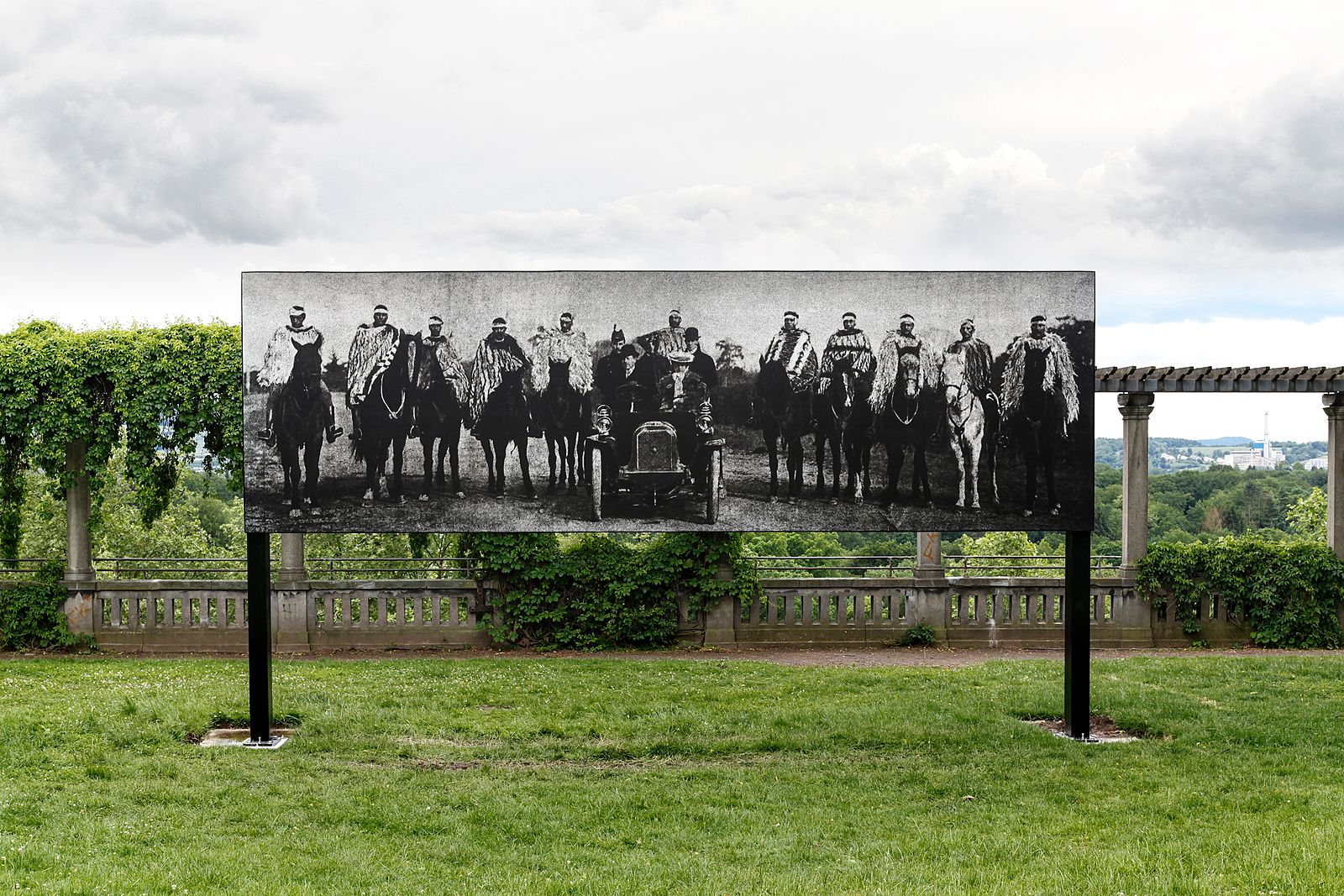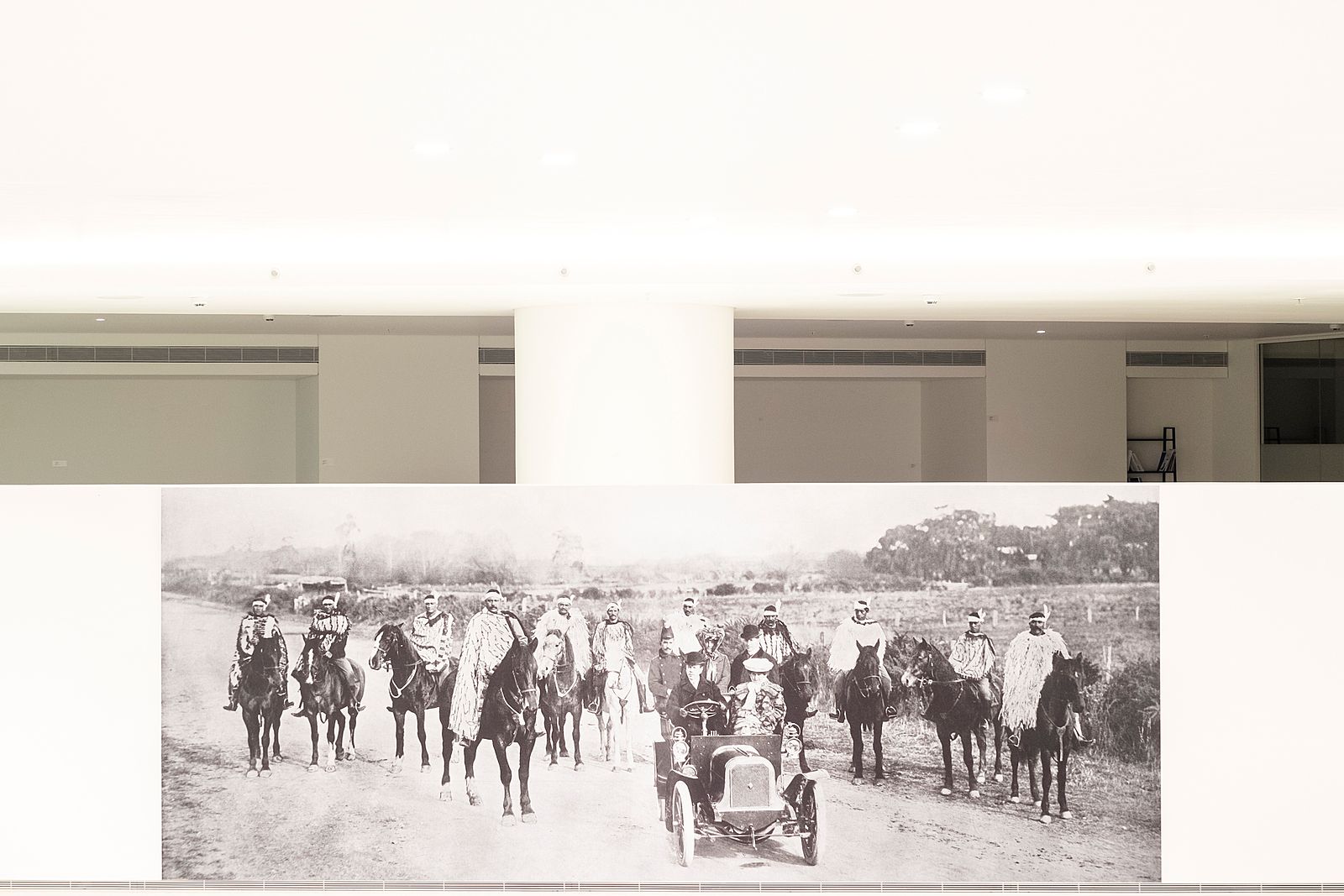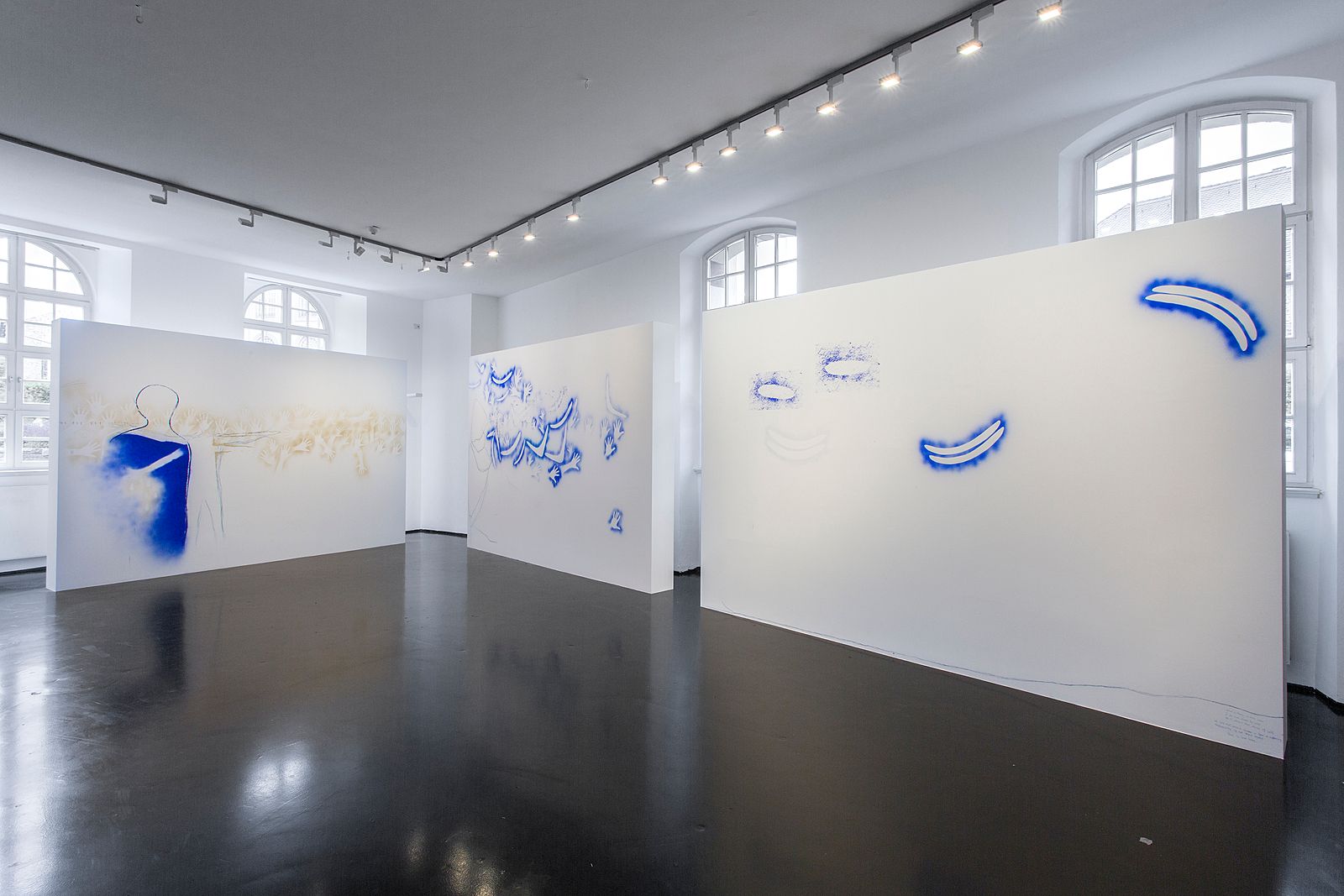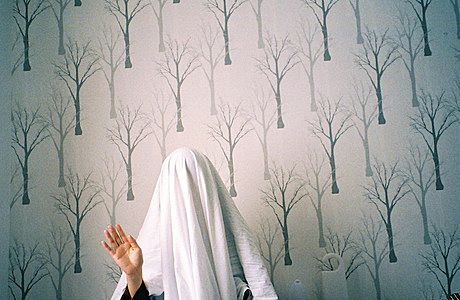An opera of the copy: Responding to work of Nathan Pohio at documenta14
Reframing the copy, Rachel O'Neill considers Raise the anchor, unfurl the sails, set course to the centre of an ever-setting sun!
Reframing the copy, Rachel O'Neill considers Raise the anchor, unfurl the sails, set course to the centre of an ever-setting sun!
It’s not everyday that an artwork elicits in me an overflowing of thought and emotion, a de-centering of my very pulse by way of unprecedented motion, a cinematic, even operatic break in the heart of space and time that leaves me feeling breathlessly alive and equipped with curiosity. Nathan Pohio’s (Waitaha, Kāti Mamoe, Ngāi Tahu) contribution to documenta14, Raise the anchor, unfurl the sails, set course to the centre of an ever-setting sun!, has done so, and in the process disarmed me of a considerable amount of tired knowledge about the copy and the way I understand the place of the copy in contemporary representation.
The word copy has its roots in the Latin copia meaning ‘abundance’. Abundant in the Latin means ‘overflowing’. Throughout this piece I will attempt to communicate the feeling of reading the copy in relation to whakapapa, lineages of voice, movement, migration and non-chronological experiences of time, as inspired by Pohio’s work.
I met Pohio and his mum briefly at a dinner arranged by Mata Aho Collective, in Kassel, Germany, where documenta has been held every five years since 1955. Mata Aho Collective alongside Ralph Hotere were also selected this year making Hotere, Pohio and Mata Aho Collective the first artists from Aotearoa to be selected since documenta’s inception. That six Māori artists were selected for one of the most significant manifests of making and dialogue around contemporary art, is a sign of the health and scope of contemporary practices grounded in mātauranga Māori.
documenta14 takes place in 2017 over 163 days in Kassel and in Athens, Greece, a decision made by the artistic director, Adam Szymczyk. Some works are reproduced, or repeated with variation in both places, while other works remain firmly or loosely unrepeatable and reside in one city only. Within Szymczyk’s curatorial framework, the historical and contemporary effects and affects of debt, de/colonisation, migration, and shared and distinct cultural and social reproduction self-consciously connect Kassel and Athens. Raise the anchor, unfurl the sails, set course to the centre of an ever-setting sun! offers insightful ways to approach, animate and trouble these proposed connections, on the whole by way of a welcoming light.
Pohio’s documenta work consists of two reproductions of photographs taken moments apart in 1905. Both photographs have been enlarged to billboard scale, one reproduction installed in Kassel and the other installed in Athens. The documenta14 programme in Athens ran this year from April 8–July 16, while the programme in Kassel ran from June 10–September 17. Pohio’s two works share a temporal overlap; they share a moment in time. The time-based poetry of the work gains conceptual nuance when we consider the context of the 1905 photographs.
Both photographs commemorate the visit of the British Governor General, Lord Plunket, and his wife, Lady Plunket, to Tuahiwi, home of Ngāi Tūāhuriri, a hapū of Ngāi Tahu. documenta14 curator Hendrik Folkerts offers further details about the photographs. Of the reproduction exhibited in Kassel he writes, “… Ngāi Tahu leaders are represented in full ceremonial dress on horseback – a reference to the traditional Ngāi Tūāhuriri pōwhiri… – while the representatives of the British Crown are seated in their motorcar.” This photograph was originally printed in the The Canterbury Times in 1905 to mark the occasion. Folkerts goes on to say of the image exhibited in Athens, “Shot seconds before this is the second, lesser-known photograph, which captures the assembly moving toward the marae… where the pōwhiri ceremony begins – the act of getting ready for the camera, an image of transition and becoming.”
Curator Rhana Devenport quotes Pohio as describing the work as “The shortest film ever made”. Curator Natasha Conland first proposed this apt description when speaking of Pohio’s Walters Prize 2016 nomination for the iteration of Raise the anchor, unfurl the sails, set course to the centre of an ever setting sun! that was installed on the Ōtākaro riverbank in 2015. Pohio’s documenta14 works are installed across space – in Kassel and Athens – as well as time, effectively becoming a cinematic moving image.
The large-scale billboard in Kassel is installed on the Weinberg-Terrassen and faces the Grimmwelt Kassel – a museum devoted to the life, work, and times of the Brothers Grimm. Within the museum are documenta14 projects that “invoke language and literature and conjure the tenebrous ambivalences of fairy tales and their dark moral fervor.”
One of these is a series of painted panels by Bruno Schulz (1892-1942), an extraordinary Polish Jewish writer, artist and teacher who lived in Drohobych, present-day Ukraine. The panels are of Grimm fairytale figures, painted in pastel hues by Schulz in what was at the time a nursery in the home of senior Nazi SS officer Felix Landau. Landau admired Schulz’s artwork and offered him protection in return for painting the mural. I had heard of these panels before through a friend who knew a filmmaker, Benjamin Geissler, who had created a to-scale multi-media reconstruction of the panels called The Picture Chamber of Bruno Schulz.
The digital reconstruction is important to note as the paintings, when rediscovered in 2001 and made public, were cut out of the house in what had become the pantry, without permission from the residents. Five wall fragments were transported to Israel and are now held in Yad Vashem, the international institute for Holocaust research in Jerusalem. Five other fragments discovered later, removed and restored, are now held in the Drohobych Museum. These were the panels I saw in Kassel. Some of the subjects of Schulz’s painted panels are said to resemble members of Landau’s family, including his children, and others are said to resemble Schulz himself. Schulz was shot dead in 1942 as he returned to the Drohobych Jewish Ghetto with a loaf of bread.
Like Schulz’s panels – which are seeming close-ups of complex contracts –Pohio’s work also asks questions about the challenges of properly ‘preserving’ and acknowledging the legacies, memories and meanings of violence and peaceful resistance in the face of broken contracts, trust and relations, while building human connections in their light.
*
Pohio’s work references cinema – the rich legacies of sound and moving image that are thousands of years in the making, developed across many cultures. Closer to our end of the timescale are genre films like the Spaghetti Western. Sergio Leone’s films are famous Westerns, often identified as Horse Operas because his scores – inspired by Italian opera – associate each character with a distinctive musical theme. You can hear the cowboys coming. Though, what are they fighting over and for?
Barclay’s scholarship and practice outlines a tikanga or protocol of representing Māori on screen, in which the subject grants the image-maker the right and responsibility to care for, rather than use, their image.
In an episode of Koha, broadcast on New Zealand television in 1987, esteemed filmmaker Barry Barclay speaks about the importance of Māori telling Māori stories. He says, “We’ve seen heaps of pictures of cowboys and Indians eh, but they’re always made by the cowboys.” In Koha Barclay also speaks about mastering film technology and then from there having “first of all the confidence and then I think the humility to use it, in with the grace and the aroha and all that, all the concepts that are natural as you know to Māori things.” Barclay’s scholarship and practice outlines a tikanga or protocol of representing Māori on screen, in which the subject grants the image-maker the right and responsibility to care for, rather than use, their image. In the same episode, pioneering filmmaker Ramai Hayward reiterates that the people in the film Rewi’s Last Stand are not images they “are taonga”.
The title of Pohio’s work is an exclamation with the touch of the epic about it, the Western at sea. While Pohio’s title and work as a whole revels in an appreciation of genre, it does so with a remastering touch, one that disarms tired myths and tropes that reinforce corrupt power dynamics and structures of dispossession without losing the thrill, intimacy and ‘charge’ of what it means to take an active role in representing legacies of relationship, both unjust and just, that continue to shape the present.
*
Unlike the first photograph in Kassel, the second, in Athens, appears to have been shot not from the ground and in the centre of the party, but from higher up and to the far left. It is as if the cameraperson stepped to the side of the road and jumped on a car, horse or tree limb and snapped the welcoming party and the honoured guests in the process of moving through to the welcome, closer to the commemorative pose. We get more of a wide shot, more context of Tuahiwi, the place of the pōwhiri. In this sense we pay attention to the place in the welcome. We see mountains in the distance, trees, cleared fields, dwellings, fence posts and the dirt road that dissects the image diagonally, creating a kind of triangle on which everyone travels.
In front of these landmarks, the horses are at their leisure, and the motorcar, in which the representatives of the Crown sit, looks marginally less like a Buster Keaton set-piece that’s about to fall forwards. Pohio’s billboard-scale photograph is mounted on the second-floor landing and looks down over the ground foyer of the EMST – National Museum of Contemporary Art in Athens. There is much space and depth between those in the image and those looking up from the ground floor, and yet that travelling triangle is generous, as is the so-called distance in time.
Merata Mita’s 1983 kōrero with Cushla Parekowhai is a defining conversation in Aotearoa filmmaking and one I will keep learning from throughout my life. At one point Mita brings up Walter Benjamin. She says, “He talks about the power of speech making and how as words are ejected up into the sky the impact they have on the people assembled is as if suddenly there is a bolt of lightening or a flash of insight. And I thought of those who do whaikōrero and make speeches on the marae. I thought how best to explain what happens in these highly charged situations.”
It seems fitting to reflect on the human voice in relation to Pohio’s reproductions, touching on the welcome call, and nodding to what Mita describes by way of Benjamin as charge, insight and light in relation to whaikōrero.
Much of my thinking here occurs alongside An Opera of the World by Manthia Diawara that premiered at documenta14. Diawara’s film orientates around filmed rehearsals for the opera, Bintou Were, a Sahel Opera, based on a libretto by the Chadian poet and playwright Koulsy Lamko. The opera is staged on the banks of the Niger River in Bamako, Mali. Title character Bintou Were is a young woman who questions and converses with fellow workers and elders with passion, self-possession and vulnerability. Monika Szewczyk writes that Bintou Were is “pregnant with child and protecting herself from suitors who, like the man who raped her, wish to take advantage by claiming fatherhood – as well as the smuggler who seduces these desperate people northward.”
Media footage of refugees to Europe is woven throughout the film. On hand-held camera a Syrian man stands beside his friend as a cold wind batters them on the foreshore. He calls out to the Mediterranean Sea, there has never been a story of more woe than my people, the Syrian people. Agitated waves roll his voice in the carnage of debris, the wakes of empty boats and all the voices it will keep and keep. In later footage a man on a boat points to floating debris. He holds the baby in the lifejacket upside down. We wait for the water to pour out.
If thought is carried by many people, many imaginations, to ‘think’ is conditioned on connection between people across space and time.
It is through Diawara’s scholarship that I have become familiar with the work of Martinican philosopher Édouard Glissant. Glissant writes in Poetics of Relation that “thought spaces itself out into the world.” If thought is carried by many people, many imaginations, to ‘think’ is conditioned on connection between people across space and time. Thinking could be understood as plural risk-taking, where agency centers on the responsibility we take for our local actions as this plural risk-taking manifests in and through us.
Throughout An Opera of the World Diawara brings together European critics of opera and philosophers to think and risk together, including Fatou Diome, Nicole Lapierre, Richard Sennett, and Alexander Kluge. At one point Kluge comments that opera moves people because the voice carries who we are, the mother and father. In a later discussion, they discuss cultural appropriation and describe this as what happens when the culture is desired but not the people and their struggle.
In The Undercommons: Fugitive Planning & Black Study, authors Stefano Harney and Fred Moten write that “It is not possible to speak of a labour that is dedicated to the reproduction of social dispossession as having an ethical dimension.” (pg 37.) The authors then go on to complicate what a critique of social dispossession is in service of, given the way critique is often a tool used to ‘correct’ the individual into further productive and common acts of dispossession. Finally, they write, “The undercommons might by contrast be understood as wary of critique, weary of it, and at the same time dedicated to the collectivity of its future, the collectivity that may come to be its future.” (pg 38.)
An Opera of the World welcomes its audience to West African opera and shows that any form that is ‘for the people’ rather than a select few is a motion, of motion, and moves with the people who lend it voice, which always connects us to who we are and where we’ve come from. The labour of the voice is directed toward “the collectivity that may come to be its future.”
Raise the anchor, unfurl the sails, set course to the centre of an ever-setting sun! proposes a series of frames and calls that connect places: Aotearoa, Germany, Greece, Mali, Syria and beyond. People from these places are heard, are listening in an unprecedented and extreme wide-shot, or wide-sound, in motion. Time gathers us all together, or it might be more accurate to say, we are the gatherers and hosts of vocal families of time.
I’d like to acknowledge here art critic Jon Bywater who has a long and deep engagement with Pohio’s practice. Bywater speaks insightfully about Pohio’s work in terms of sampling in the context of contemporary music, particularly Hip hop.
*
Dale Harding is a descendant of the Bidjara, Ghuungalu, and Garingbal peoples of Central Queensland. His documenta14 work, Composite Wall Panel: Reckitt’s Blue (2017), is a to-scale replica of stencil artwork by Garingbal/Bidjara artists at Carnarvon Gorge. It is silk-screened onto white walls in Reckitt’s Blue, a colour that was introduced “to Indigenous art following contact with European missionaries”.
Harding’s work challenges a view of the copy as mute surface, echo of loss, or mono-vocal relationship; a poor cousin to representations that through multiplicity and motion carry voices, story, names, people and their combined energy of artistic practice and exploration of the human condition. The dynamic movement and motion of representation, the lineage of meaning and value across time is foregrounded. Artist’s hands are layered and what we can see, though not literally visible, are kinds of memories or human passports of touch.
In Harding’s work the human hand continues to be understood in relation to other hands across time, making me think about how relationships can be kept animate – celebrated and held to account – through the copy. At the same time, I think about what can’t take the shape of a copy at all. It will come as no surprise that it’s impossible to copy the earth, and people. You can’t copy the brain or the heart. You can spark, extend and use the imagination, though you can’t copy it. You can’t copy relationships as if they were static, as if they weren’t an intricate web of ongoing greetings and partings, sound and silence. Perhaps all that we can’t copy can reveal fundamentally who and what requires our care.
A wrong system tries to turn people into privatised originals, locks us into the labour of dispossession, asserting our asocial predominance in time. A person however, will always be an agent whose agency is made of collective relationships of never-before and never-again, here and now, moving, shaping, imagining, and all the guidance of all voices from all the families of time.
*
Given the evident strength of Pohio’s work and the conversation it is part of, as with the powerful contributions by Hotere and Mata Aho Collective, I feel a deep loss at (what looks set to be) a bare minimum of responses from local writers to their documenta14 works, particularly articles of the calibre of say Emilie Rākete’s ‘In Human Parasites, Posthumanism and Papatūānuku’, published in the Documenta14 Reader.
My lens as a writer is a specific one. I was born in Tokoroa and grew up in the Waikato. The land that my parents farmed was composed of peat, a soil that’s 40,000 years old and shaped by the course of the Waikato river and tributaries over centuries. It was radically altered over a period of 100 years. The ‘Piako block’ was part of 1865 land confiscations by the New Zealand Government, which followed the invasion of the Waikato during the New Zealand wars. When Pākehā colonisers drained the ‘swamps’, the land became prone to underground fires in summer. In a 1946 newsreel of a Piako peat fire, shirtless men dig long grave-like trenches to halt the spread of the flames, at war with the earth. I am a Pākehā queer storytelling underground-fire swamp creature made of and complicit in these legacies.
In responding to Pohio’s work I acknowledge that there are limits to my knowledge and experience. In addition, acknowledging the tikanga around taonga throughout its travels, how it’s supported on the return journey home, and the meaning of that, is crucial. Creative New Zealand in partnership with our art and literary leadership organisations and editors should have proactively resourced and supported Māori writers to play an active role in the homecoming of these documenta14 works that are clearly shaping and enriching contemporary aesthetics.
*
Copies can give scope to people’s walking, voices and relationships, people’s sense of home and destination. Copies can be originals divesting asocial power and shaping alternative kinds of agency.
Without each other we get nowhere. The destination stays away.
Copies can give scope to people’s walking, voices and relationships, people’s sense of home and destination. Copies can be originals divesting asocial power and shaping alternative kinds of agency. Some days we might just want to keep it simple. All that can’t be copied can help show us what is at stake when we do or don’t act, and why. All that can’t be copied can help show us what is at stake when we think and imagine with a collective future at heart, where dispossession of people to ensure the health and happiness of the greedy isn’t where we start from or what we breathe life into.
At the heart of Raise the anchor, unfurl the sails, set course to the centre of an ever-setting sun! are people, who are taonga, who are light – where light is understood in relation to voice and insight as much as photographic medium. The work proposes that destinations that hold together – that come towards us in ways that are social, strong and connected – are grounded in manaakitanga.
I dare to hope we will achieve a treaty-based constitution in the near future. I believe in working towards this because Te Tiriti o Waitangi is a living relationship. Meaningful relationships between people in Aotearoa are only possible when we honour this foundation, and when Māori values of kaitiaki for both the earth and the people are where we begin from and return to.
We are made of our invitations, the places they are from, the organising that happens through them because they are grounded in relationships that can remain meaningful in perpetuity, for generation and generation. Pohio’s work has helped me see that we are made of our invitations, the atawhai with which we issue and respond to them.
Rachel would like to thank Nathan Pohio for his generous conversation, Lana Lopesi for her erudite editing, and the kind friends who gave feedback on the piece as it evolved.




